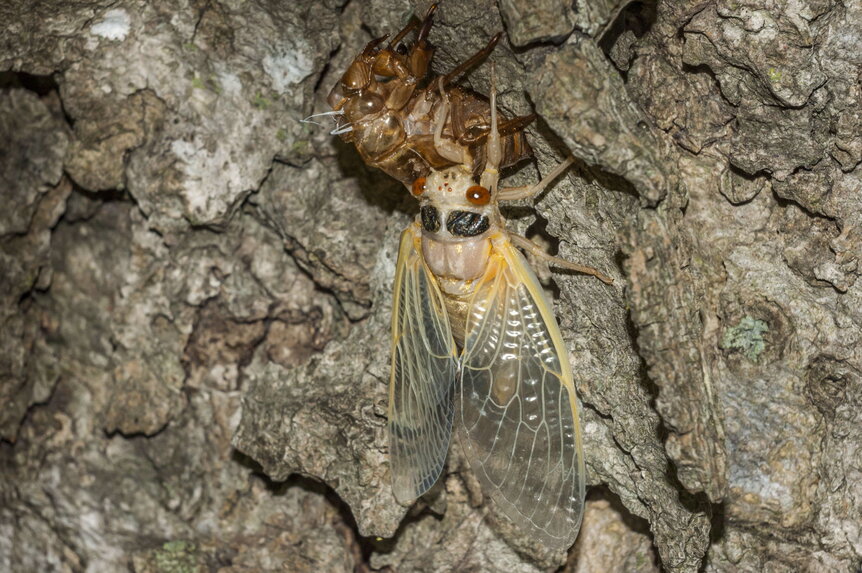Create a free profile to get unlimited access to exclusive videos, sweepstakes, and more!
It’s a bird? It’s a plague?! Relax, it’s just billions of giant ‘Brood X’ cicadas prepping to swarm the U.S.

It’s a good thing these guys are relatively harmless, because in a few weeks, the eastern part of the U.S. will be absolutely mobbed by them — and they’re enormous. If you’ve never seen a cicada (and no, not that kind), next month won’t just be a prime cicada-viewing opportunity: it’ll be the start of more than a month of total “they’re everywhere!” saturation of the giant insects for people who live in eastern and southern U.S. states.
Unlike locusts (with which they’re sometimes confused), “periodic” cicadas aren’t the insects responsible for plagues and property-chewing infestations. But their eldritch gestational cycle is the stuff of sci-fi nightmares.
Periodic cicadas (distinct from “annual” cicadas thanks to their lengthy spawning patterns) have such long gestational spans that their years-in-the-making hatching events get human-sounding generational names. And the name for this year’s batch is especially freighted with scary sci-fi infestation implications, even if the super-sized insects themselves are all bark and no bite. No, that won’t be a freight train outside your window next month: it’s just “Brood X,” the uniformly agreed-upon name that scientists are calling this year’s cicada wave.
The size of small hummingbirds, these cicadas have a physical presence that’s the envy of any insect bent on striking fear into the hearts of people. Their eyes are red, their wings are nearly transparent, and their bodies are about the size and shape of a human thumb — and they leave a creepy, Alien-looking exoskeleton; one only slightly smaller than their final adult form, behind when they molt. But Brood X’s fear factor pretty much begins and ends in the imagination, because it poses nary a threat to humans…other than the one that stirs your instinct to get far, far away from something so freaky.
“They don’t really have any defenses. Their only defense is their numbers,” Matt Kasson, a cicada scientist at West Virginia University, recently explained to The Washington Post. “…They basically fill up every predator on the planet when they emerge, so every bird, snake and fish within range will just basically gorge themselves on cicadas, and yet there will still be plenty left to persist.”
He’s not kidding: Brood X could end up spawning cicadas “in the hundreds of billions, maybe even pushing into trillions,” Kasson later added…and somehow, we’re supposed to believe the chorus of scientists who’re trying to assure us that’s totally okay.
Living up the “periodic” part of their description, periodic cicadas like those of Brood X spend nearly their entire 17-year lifespans underground, subsisting on the root tissue of trees. Then in year 17 (some species only make it to year 13 before starting this process), some alchemical secret of biology compels them to emerge from the ground all at once, putting on a spectacle of sight (and sound) that’s nearly impossible for humans to avoid.
In early May and continuing through June, mature cicada nymphs — some of which can approach 3 inches in length — are triggered by warming soil temperatures to burrow out of their underground abodes in unison, ascending trees to molt their juvenile exoskeletons and grow new adult ones. Their new hard shells will serve them only for the short 4-6 week remainder of their above-ground lives, but at least they go out in style: all of their adult lives, once they’ve emerged from the dirty depths, is devoting to mating.
Finding a procreative partner is where the cicadas get to show off the other freaky trait they’re famous for: their singing. The sound of millions upon millions of male cicadas calling out in unison on a warm spring night is a signature seasonal event for residents in the southern and eastern U.S., as are the light-brown, desiccated husks of their molted exoskeletons, which litter the earth in regions both urban and rural like the hollowed-out remnants of a failed insect invasion.
There are, of course, “annual” cicadas that do these same types of things every spring. But in years like this one, when an entire 17-year gestational cycle is coming to fruition all at once, the period between early May and late June has all the visual and audible hallmarks of one giant insect storm. We guess it’s a reason to celebrate, if you happen to be an entomologist. But the cicadas of Brood X will probably never really grasp the next-level creep factor that they’re bringing to the spring of 2021 for everybody else.



























